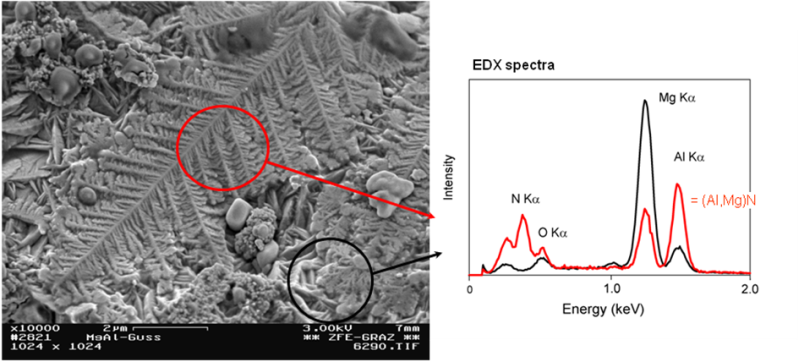Energy dispersive x-ray spectrometry
To determine the chemical composition of the sample which is to be tested, the x-ray spectrum emitted by the sample must be dissected. There are two different methods of doing this.
In classic EDX analyses, a detector crystal which is polarized as a diode in a non-conducting direction and is under high voltage is used. This is made of silicon fortified with lithium or of high purity germanium (HPGe). To prevent disruptive internal noise at room temperature and the diffusion of the lithium (Li) in the crystal, the crystal and the preamplifier are cooled to the temperature of the liquid nitrogen. This is contained in an evacuated dewar and cools the crystal and the preamplifier via a cold finger made of copper.
To prevent a contamination and formation of ice on the crystal, it is shielded by a thin detector window facing the sample. The detection of light elements is possible form the elementboron. An x-ray quantum which hits the crystal creates an energy in it which is proportional to the number of electron-hole pairs. To create such an electron-hole pair, 3.8eV are needed in an Si(Li) detector. These can be tapped and strengthened as a voltage pulse on the crystal. In a pulse height analyzer (multichannel analyzer: a range of impulse counters, each of which is allocated a specific energy a registered impulse increases the count by one unit), their energies can be assigned according to their count.
An EDX detector has a relatively long downtime - this means that, after registering a photon, the detector needs a certain amount of time before it is ready to detect the next photon. The elements in the sample can be inferred from the individual x-ray lines (Figures 1 and 2). The concentration can be calculated using quantitative process from the relative intensity of the x-ray lines in relation to one another.
The Silicon Drift Detector (SDD) is an energy-dispersive x-ray detector based on a silicon drift chamber. An integratede FET as signal amplifier ensures a good energy dissolution (approx. 124eV). The principle of lateral impoverishment, the implemented drift structure and the very small anode ensure a very small detector capacity. An especially developed and optimized signal elaboration technique makes an extremely high pulse flow rate possible without loss of accuracy. The pulse flow rate of SD detectors is more the 10 times higher than the one of classic EDX detectors. The detector crystal is cooled through a vibration-free thermoelectric cooler. Liquid nitrogen is not necessary for cooling. An ultrathin beam entrance area separates the sensible detector area from the sample chamber.
EDX systems have become widely used as they can capture the entire x-ray spectrum at the same time and statements about the chemical composition of the sample are possible after only a short time. In the ideal case, the sensitivity of detection is around 0.1% by weight. The energy resolution (given for MnKa) is
Additional references:
Electron microscope
Electron microscopy
Electron probe
element distribution
Environmental scanning electron microscopy
scanning electron microscopy
wave-length dispersice x-ray spectroscopy
Literatue:
Schröttner H. : Die Elektronenmikroskopie in der Materialforschung / Electron Microscopy in Materials Research.


